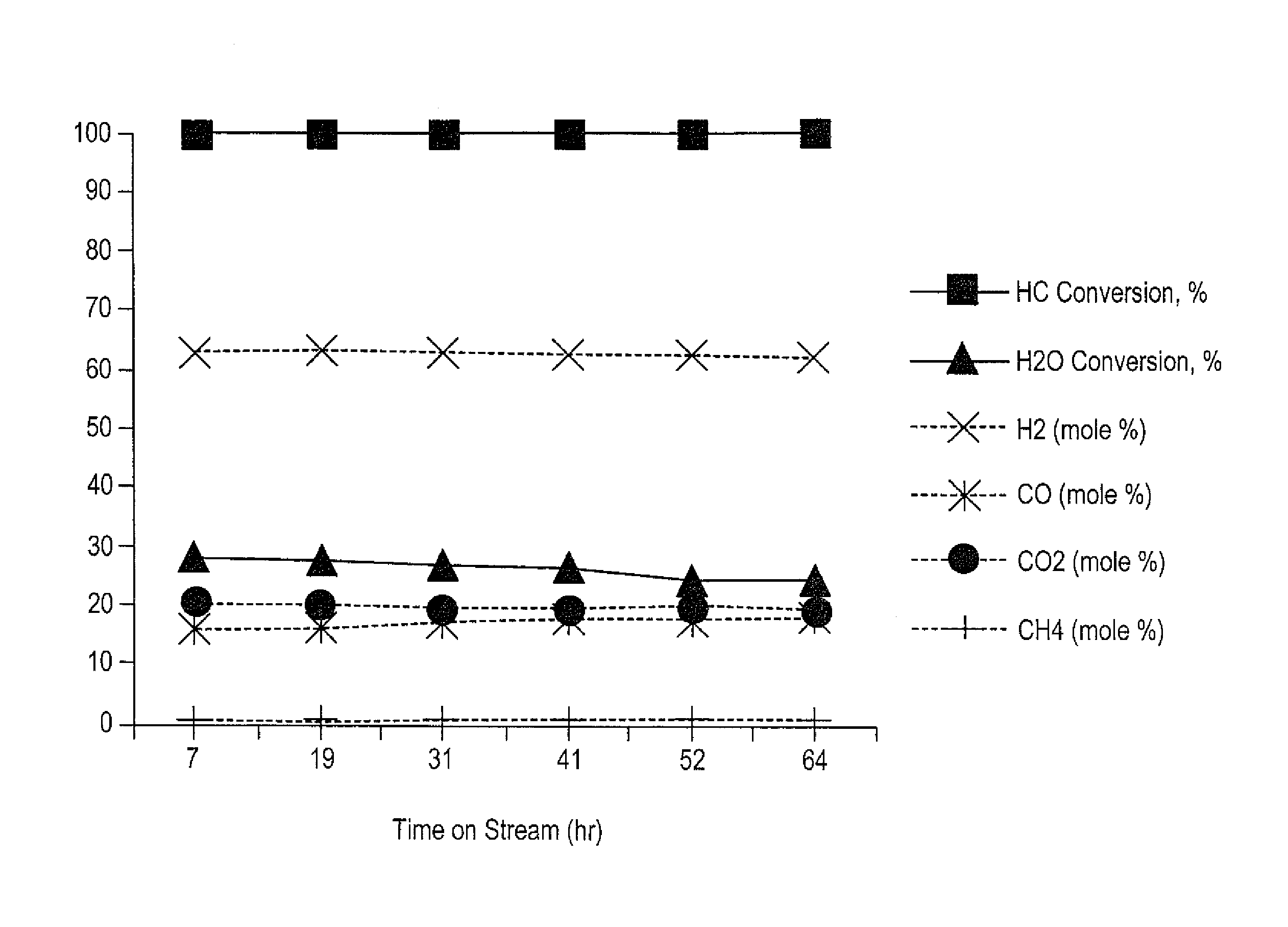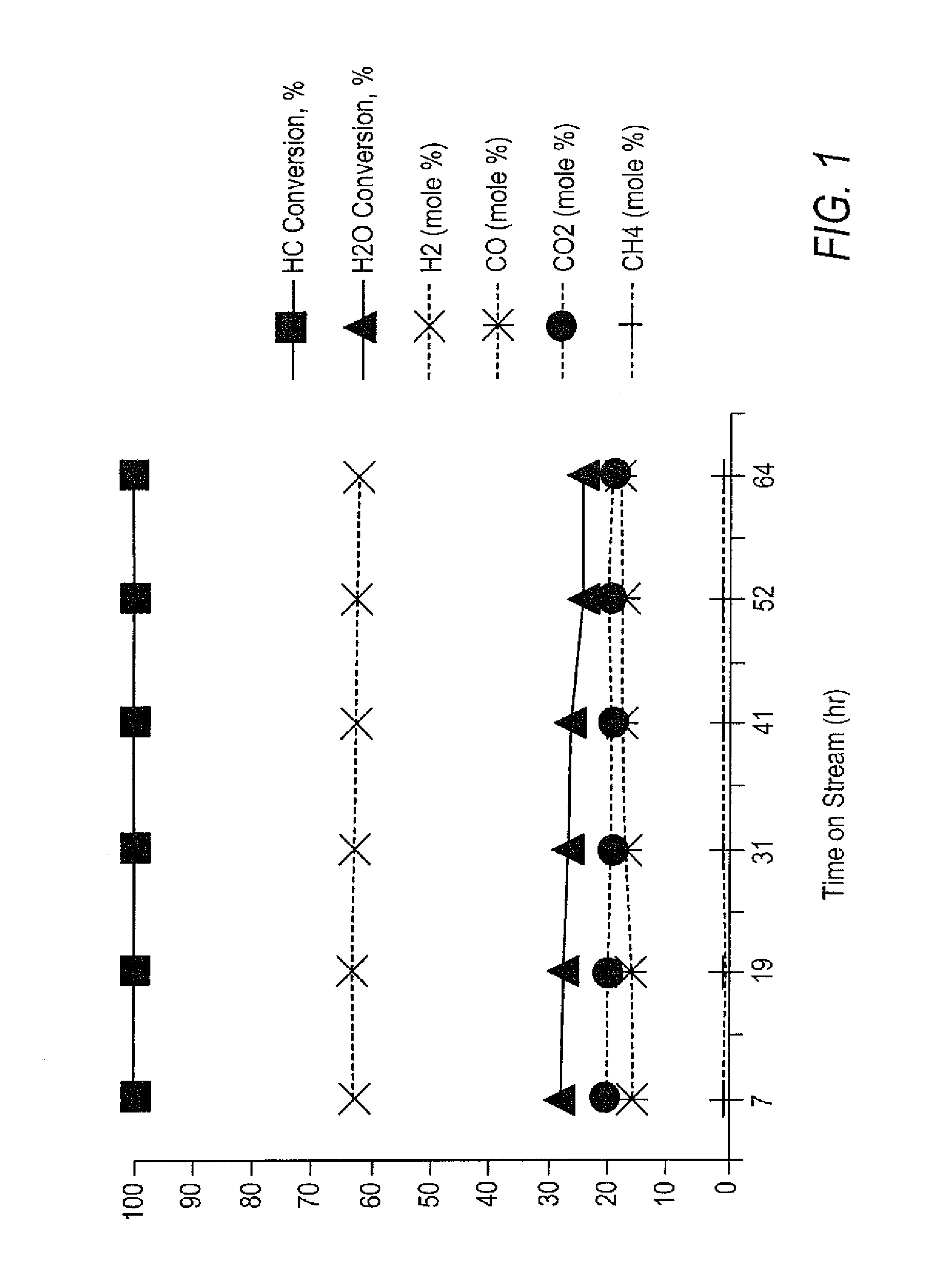Catalyst and process for thermo-neutral reforming of liquid hydrocarbons
a liquid hydrocarbon fuel and catalyst technology, applied in the field of catalysts and thermoneutral reforming processes for petroleum-based liquid hydrocarbon fuels, can solve the problems of increasing the amount of hydrogen needed, the inability of catalysts to produce syngas or hydrogen, and the difficulty of using pure hydrogen as a fuel in automotive and residential applications, so as to improve catalyst life, reduce reactor size, prevent or minimize
- Summary
- Abstract
- Description
- Claims
- Application Information
AI Technical Summary
Benefits of technology
Problems solved by technology
Method used
Image
Examples
example 1 (
PRIOR ART METHOD)
Catalyst Preparation Method
[0041]This example describes the preparation of a seven multi-component catalyst for use in the Thermo-Neutral process reformed in accordance with the prior art (U.S. Pat. No. 7,700,005).
[0042]The catalyst was prepared by impregnating alumina spheres of diameter in the range of about 2 to about 4 millimeters and surface area of the support is from about 85 square meters per gram. One hundred and thirty-one grams of support-type alumina were impregnated with 75.6 ml of aqueous solution containing 0.84 grams of rhodium nitrate III (CAS 10139-58-9—Sigma Aldrich, product code 83750) and 0.59 grams of rhenium oxide VII (CAS 1314-68-7—Sigma Aldrich product code 1314-68-7). The catalyst was dried from ambient temperature to 60° C. at a rate of 0.5° C. / min and then exposed to 60° C. for 10 minutes at an NH3-rich atmosphere. Then the catalyst was thermally treated for 60° C. up to 120° C. at a rate of 1° C. / min and after for 120° C. up to 350° C. a...
example 2 (
PRESENT INVENTION WITH 7-COMPONENT CATALYST A)
Catalyst Preparation Method
[0060]This example is in accordance with the present invention describes the preparation of seven multi-component catalyst using magnesium aluminate as a support. The magnesium aluminate was prepared by calcination a commercial hydrotalcite (SudChemie, product code T-2701 1 / 16 inch, with 30% w / w of MgO in alumina balance) at 1050° C. in air for 4 hours. The support had a surface area 67.6 m2 / g, pore volume of 0.35 cm3 / g by N2 adsorption and 0.9 cm3 / g by water absorption and standard X-ray diffraction characteristic of the magnesium aluminate. The catalyst was prepared in a manner identical to Example 1 except final reduction step was conducted at 730° C. instead of 1160° C. The final catalysts had a nominal composition of (% w / w): 0.2% Rh; 0.3% Re, 0.8% Pt, 1.0ZrO2, 1.% La2O3, 6% Ni, 3% Ce2O3 supported on magnesium aluminate.
[0061]
Catalyst Prep.ExamplesCatalyst ComponentsSteps (summary)ANi—Ce2O3—La2O3—Pt—ZrO2—R...
example 3 (
PRESENT INVENTION WITH 4-COMPONENT CATALYST B)
Catalyst Preparation Method
[0074]This example, which is in accordance with the present invention describes the preparation of multi-component catalyst having four components using magnesium aluminate promoted with K as a support. The support of magnesium aluminate was prepared as: 200 grams of commercial hydrotalcite (SudChemie, product code T-2701 1 / 16 inch, with 30% w / w of MgO in alumina balance) were impregnated with 180 ml of an aqueous solution containing 7.37 g of potassium hydroxide. The material was dried overnight at 100° C. and then calcined at 1050° C. in air for 4 hours. The support had a surface area 85.7 m2 / g and pore volume of 0.70 cm3 / g. 174 grams of the prepared support was impregnated with 140 ml of aqueous solution containing 0.70 g of tetraamineplatinum (II) chloride monohydrate (CAS 13933-33-0 Alfa Aesar product code 10836), 5.14 grams of lanthanum nitrate hexahydrate (CAS 10277-43-7 Alfa Aesar, product code 44346), ...
PUM
| Property | Measurement | Unit |
|---|---|---|
| Temperature | aaaaa | aaaaa |
| Temperature | aaaaa | aaaaa |
| Temperature | aaaaa | aaaaa |
Abstract
Description
Claims
Application Information
 Login to View More
Login to View More - R&D
- Intellectual Property
- Life Sciences
- Materials
- Tech Scout
- Unparalleled Data Quality
- Higher Quality Content
- 60% Fewer Hallucinations
Browse by: Latest US Patents, China's latest patents, Technical Efficacy Thesaurus, Application Domain, Technology Topic, Popular Technical Reports.
© 2025 PatSnap. All rights reserved.Legal|Privacy policy|Modern Slavery Act Transparency Statement|Sitemap|About US| Contact US: help@patsnap.com



